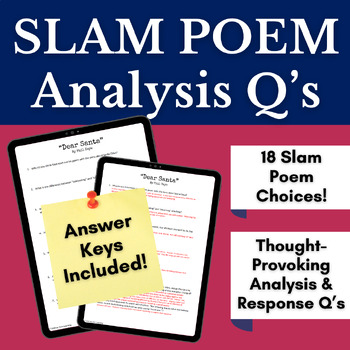Slam Poetry Close Reading Analysis Questions for Middle School and High School
- PDF
- Easel Activity
What educators are saying
Also included in
- These no prep, digital and print, slam poetry / spoken word poetry activities, poetry graphic organizers, and question response handouts are designed to help students practice close reading skills and save you time! Engage students as you build writing, reading, speaking and listening, and meta-cogPrice $11.20Original Price $16.00Save $4.80
- This engaging Slam Poetry MEGA Bundle (with a slam poetry unit plan) gives you everything you need for teaching slam poetry in your middle school or high school English classroom. Students will grow as writers and thinkers as they appreciate, analyze, write, and perform their own slam poetry. Save pPrice $41.65Original Price $59.50Save $17.85
Description
Slam Poetry Comprehension and Analysis Questions for 18 different spoken word poems will give you a variety of “go to” slam poems that are engaging, yet challenging for students. With a blend of spoken word comprehension, analysis, and response questions, with multiple choice and short answer formats, you can help students to be accurate and perceptive, analytical and connected audience members.
Complete with detailed answer keys, this no-prep resource is perfect for differentiation, extension, whole class modeling, small group activities, and test-prep!
Slam Poems Include:
★"Dear Santa"
★"Apartment on Austin"
★"Buffet Etiquette"
★"Why Falling in Love is Like Owning a Dog"
★"Toothbrush to a Bicycle Tire"
★"Lebron James"
★"Complainers"
★"Pretty"
★"Totally Like Whatever, You Know?"
★"To the Boys Who May One Day Date My Daughter"
★"Explaining my Depression to My Mother"
★"If I Should Have a Daughter"
★"My Father's Coat"
★"Knock Knock"
★"Emergency Exit Row"
★"Look Up"
★"Touchscreen"
★"Tony Steinberg: Brave Seventh Grade Viking Warrior"
*************************************************
Here’s what you’ll receive in this resource:
★Slam Poetry Question Worksheets and Answer Keys (36 Pages) so that you have questions for 18 clean and engaging slam poems.
★Teacher Notes & Slam Poem Links (2 Pages) so that you can have everything you need ready-to-go!
This resource is helpful for:
★ Teachers who are looking to save time with ready-made resources.
★ Teachers who love using spoken word poetry in the classroom.
*************************************************
Let's Connect!
★ Stop by the Lindsay Ann Learning Blog!
*************************************************
Copyright © 2017-Present, Lindsay Ann Learning
⇒ Permission for use by one teacher in his or her own classroom.
⇒ Not for public display or digital sharing.
⇒ If you intend to share with others, please purchase an additional license.








